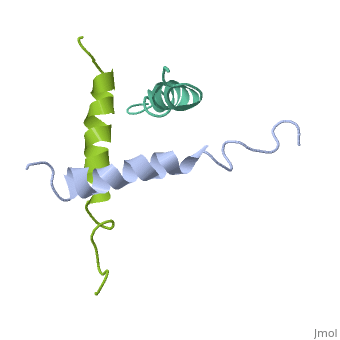1bh0
From Proteopedia
(Difference between revisions)
| Line 9: | Line 9: | ||
== Function == | == Function == | ||
[https://www.uniprot.org/uniprot/GLUC_HUMAN GLUC_HUMAN] Glucagon plays a key role in glucose metabolism and homeostasis. Regulates blood glucose by increasing gluconeogenesis and decreasing glycolysis. A counterregulatory hormone of insulin, raises plasma glucose levels in response to insulin-induced hypoglycemia. Plays an important role in initiating and maintaining hyperglycemic conditions in diabetes.<ref>PMID:8482423</ref> <ref>PMID:14557443</ref> <ref>PMID:14632334</ref> GLP-1 is a potent stimulator of glucose-dependent insulin release. Play important roles on gastric motility and the suppression of plasma glucagon levels. May be involved in the suppression of satiety and stimulation of glucose disposal in peripheral tissues, independent of the actions of insulin. Have growth-promoting activities on intestinal epithelium. May also regulate the hypothalamic pituitary axis (HPA) via effects on LH, TSH, CRH, oxytocin, and vasopressin secretion. Increases islet mass through stimulation of islet neogenesis and pancreatic beta cell proliferation. Inhibits beta cell apoptosis.<ref>PMID:8482423</ref> <ref>PMID:14557443</ref> <ref>PMID:14632334</ref> GLP-2 stimulates intestinal growth and up-regulates villus height in the small intestine, concomitant with increased crypt cell proliferation and decreased enterocyte apoptosis. The gastrointestinal tract, from the stomach to the colon is the principal target for GLP-2 action. Plays a key role in nutrient homeostasis, enhancing nutrient assimilation through enhanced gastrointestinal function, as well as increasing nutrient disposal. Stimulates intestinal glucose transport and decreases mucosal permeability.<ref>PMID:8482423</ref> <ref>PMID:14557443</ref> <ref>PMID:14632334</ref> Oxyntomodulin significantly reduces food intake. Inhibits gastric emptying in humans. Suppression of gastric emptying may lead to increased gastric distension, which may contribute to satiety by causing a sensation of fullness.<ref>PMID:8482423</ref> <ref>PMID:14557443</ref> <ref>PMID:14632334</ref> Glicentin may modulate gastric acid secretion and the gastro-pyloro-duodenal activity. May play an important role in intestinal mucosal growth in the early period of life.<ref>PMID:8482423</ref> <ref>PMID:14557443</ref> <ref>PMID:14632334</ref> | [https://www.uniprot.org/uniprot/GLUC_HUMAN GLUC_HUMAN] Glucagon plays a key role in glucose metabolism and homeostasis. Regulates blood glucose by increasing gluconeogenesis and decreasing glycolysis. A counterregulatory hormone of insulin, raises plasma glucose levels in response to insulin-induced hypoglycemia. Plays an important role in initiating and maintaining hyperglycemic conditions in diabetes.<ref>PMID:8482423</ref> <ref>PMID:14557443</ref> <ref>PMID:14632334</ref> GLP-1 is a potent stimulator of glucose-dependent insulin release. Play important roles on gastric motility and the suppression of plasma glucagon levels. May be involved in the suppression of satiety and stimulation of glucose disposal in peripheral tissues, independent of the actions of insulin. Have growth-promoting activities on intestinal epithelium. May also regulate the hypothalamic pituitary axis (HPA) via effects on LH, TSH, CRH, oxytocin, and vasopressin secretion. Increases islet mass through stimulation of islet neogenesis and pancreatic beta cell proliferation. Inhibits beta cell apoptosis.<ref>PMID:8482423</ref> <ref>PMID:14557443</ref> <ref>PMID:14632334</ref> GLP-2 stimulates intestinal growth and up-regulates villus height in the small intestine, concomitant with increased crypt cell proliferation and decreased enterocyte apoptosis. The gastrointestinal tract, from the stomach to the colon is the principal target for GLP-2 action. Plays a key role in nutrient homeostasis, enhancing nutrient assimilation through enhanced gastrointestinal function, as well as increasing nutrient disposal. Stimulates intestinal glucose transport and decreases mucosal permeability.<ref>PMID:8482423</ref> <ref>PMID:14557443</ref> <ref>PMID:14632334</ref> Oxyntomodulin significantly reduces food intake. Inhibits gastric emptying in humans. Suppression of gastric emptying may lead to increased gastric distension, which may contribute to satiety by causing a sensation of fullness.<ref>PMID:8482423</ref> <ref>PMID:14557443</ref> <ref>PMID:14632334</ref> Glicentin may modulate gastric acid secretion and the gastro-pyloro-duodenal activity. May play an important role in intestinal mucosal growth in the early period of life.<ref>PMID:8482423</ref> <ref>PMID:14557443</ref> <ref>PMID:14632334</ref> | ||
| - | <div style="background-color:#fffaf0;"> | ||
| - | == Publication Abstract from PubMed == | ||
| - | We have designed and synthesized eight compounds 2-9 which incorporate various amino acid residues in positions 17, 18, and 21 of the glucagon molecule: 2, [Lys17]glucagon amide; 3, [Lys18]glucagon amide; 4, [Nle17,Lys18,Glu21]glucagon amide; 5, [Orn17,18, Glu21]glucagon amide; 6, [d-Arg17]glucagon; 7, [d-Arg18]glucagon; 8, [d-Phe17]glucagon; and 9, [d-Phe18]glucagon. Compared to glucagon (IC50 = 1.5 nM), analogues 2-9 were found to have binding affinity IC50 values (in nM) of 0.7, 4.1, 1.0, 2.0, 5.0, 25.0, 43.0, and 32.0, respectively. When these compounds were tested for their ability to stimulate adenylate cyclase (AC) activity, they were found to be full or partial agonists having maximum stimulation values of 100, 100, 100, 100, 87, 78, 94, and 100%, respectively. On the basis of the X-ray crystal structure of [Lys17,18,Glu21]glucagon amide reported here, the ability to form a salt bridge between Lys18 and Glu21 is probably key to their increased binding and second messenger activities. Among the eight analogues synthesized here, only analogue 4 preserves the ability to form a salt bridge between Lys18 and Glu21. However, since these modifications are minor they do not seem to change the amphiphilic character of the C-terminus, allowing these analogues to reach 78-100% stimulation in the adenylate cyclase assay. Biological data from analogues 6-9 supports the idea that position 18 of glucagon may influence binding only, while position 17 may influence both receptor recognition and transduction. | ||
| - | |||
| - | Structure-function studies on positions 17, 18, and 21 replacement analogues of glucagon: the importance of charged residues and salt bridges in glucagon biological activity.,Sturm NS, Lin Y, Burley SK, Krstenansky JL, Ahn JM, Azizeh BY, Trivedi D, Hruby VJ J Med Chem. 1998 Jul 16;41(15):2693-700. PMID:9667960<ref>PMID:9667960</ref> | ||
| - | |||
| - | From MEDLINE®/PubMed®, a database of the U.S. National Library of Medicine.<br> | ||
| - | </div> | ||
| - | <div class="pdbe-citations 1bh0" style="background-color:#fffaf0;"></div> | ||
==See Also== | ==See Also== | ||
Current revision
STRUCTURE OF A GLUCAGON ANALOG
| |||||||||||
Categories: Homo sapiens | Large Structures | Ahn J-M | Azizeh BY | Burley SK | Hruby VJ | Krstenansky JL | Lin Y | Sturm NS | Trivedi D

